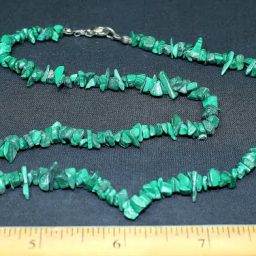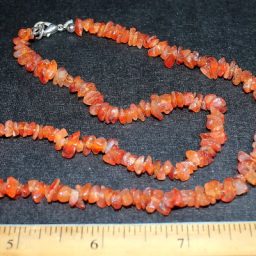Description
Botswana Agate is a distinctive and visually appealing variety of agate, a type of chalcedony that belongs to the quartz family of minerals. It is known for its unique and vibrant banding patterns, which make it a popular choice for use in jewelry and ornamental pieces.
Definition and Description: Botswana Agate is a type of banded agate that originates from the African country of Botswana, in the southern part of the continent. This variety of agate is characterized by its striking bands of various colors and patterns. The bands can range from subtle, earthy tones to more vibrant and contrasting hues, making each piece of Botswana Agate unique and visually captivating.
The bands in Botswana Agate are often wavy or irregular, and they can vary in thickness and color, creating a mesmerizing, almost landscape-like appearance. The colors in Botswana Agate can include shades of gray, pink, white, brown, and sometimes even blue or purple. The overall appearance of Botswana Agate is reminiscent of the natural beauty found in the African landscapes, hence its name.
Geological Formation: Botswana Agate forms in sedimentary rocks, typically as nodules or geodes within volcanic rock formations. The process of formation involves the slow deposition of silica-rich solutions within cavities or voids in the rock. Over time, as these solutions cool and solidify, they create the distinctive banding patterns seen in Botswana Agate. This formation process can take millions of years, during which impurities and mineral inclusions may also contribute to the unique colors and patterns within the agate.
otswana Agate has distinct geological characteristics that contribute to its formation and appearance. Here are some key geological characteristics of Botswana Agate:
Sedimentary Origin: Botswana Agate is formed within sedimentary rocks, which are rocks that result from the accumulation and compaction of sediments over a long period. These sediments can include fine particles like clay, silt, and sand.
Agate Nodules: Botswana Agate typically occurs as nodules or geodes within the host rock. These nodules are spherical to irregular in shape and can range in size from a few centimeters to several inches in diameter.
Silica-Rich Solutions: The formation of Botswana Agate involves the infiltration of silica-rich solutions into cavities or voids within the sedimentary rocks. These solutions are often saturated with dissolved silica (SiO2), which is the main component of quartz.
Band Formation: As the silica-rich solutions cool and solidify over time, they deposit layers of cryptocrystalline quartz along the walls of the cavities. These successive layers create the characteristic banding patterns seen in Botswana Agate. The patterns can vary in color, thickness, and arrangement.
Mineral Inclusions: Impurities and trace minerals present in the silica-rich solutions can contribute to the coloration and patterning of the agate. For example, iron oxides may impart red or brown hues, while manganese can produce pink or purple shades. These mineral inclusions add to the overall visual appeal of Botswana Agate.
Geological Timeframe: The formation of Botswana Agate takes millions of years, as the gradual deposition of layers within the nodules requires an extended period of time. This extended geological timeframe contributes to the unique and intricate patterns seen in Botswana Agate specimens.
Landscape-Like Appearance: The banding patterns and colors often resemble landscapes, such as desert scenes or distant horizons, which is why Botswana Agate is sometimes called “landscape agate.” These natural scenes are a result of the random and irregular deposition of minerals over time.
Location Specificity: Botswana Agate, as its name suggests, primarily comes from Botswana, located in southern Africa. The geological conditions and history of this region have given rise to the specific qualities and characteristics found in Botswana Agate.
Hardness: Botswana Agate has a hardness of about 6.5 to 7 on the Mohs scale of mineral hardness. This level of hardness makes it relatively durable and resistant to scratching, making it suitable for use in jewelry.
Luster: Botswana Agate typically has a vitreous to waxy luster, giving it a shiny and smooth appearance when polished. The luster can enhance its overall attractiveness in jewelry and decorative items.
Transparency: Botswana Agate is usually translucent to opaque. While some portions of the stone may allow light to pass through, others may be more opaque, depending on the specific specimen and its banding patterns.
Color: Botswana Agate is known for its striking and diverse coloration. Its bands can range from shades of gray, white, and brown to more vivid colors like pink, red, blue, and purple. The colors are often arranged in intricate and captivating patterns, making each piece unique.
Banding Patterns: The most distinctive physical feature of Botswana Agate is its banding patterns. These patterns can be wavy, irregular, or concentric, resembling natural landscapes or abstract art. The variety and complexity of banding patterns add to its aesthetic appeal.
Translucency: Some portions of Botswana Agate may display translucency, allowing light to pass through the stone to varying degrees. This can create a beautiful play of light and color within the bands.
Specific Gravity: The specific gravity of Botswana Agate typically ranges from 2.60 to 2.65. Specific gravity measures the density of a mineral and can help identify it when combined with other characteristics.
Cleavage and Fracture: Botswana Agate, like other varieties of quartz, does not exhibit cleavage, which means it does not break along specific planes. Instead, it has a conchoidal fracture, meaning it breaks with smooth, curved surfaces.
Polishability: Botswana Agate is highly polishable, which allows lapidaries and jewelers to bring out its vibrant colors and intricate patterns, making it an attractive choice for gemstone and jewelry enthusiasts.
Size and Shape: Botswana Agate is often found as nodules or geodes with spherical to irregular shapes. Its size can vary widely, from small cabochons used in jewelry to larger ornamental pieces or sculptures.








